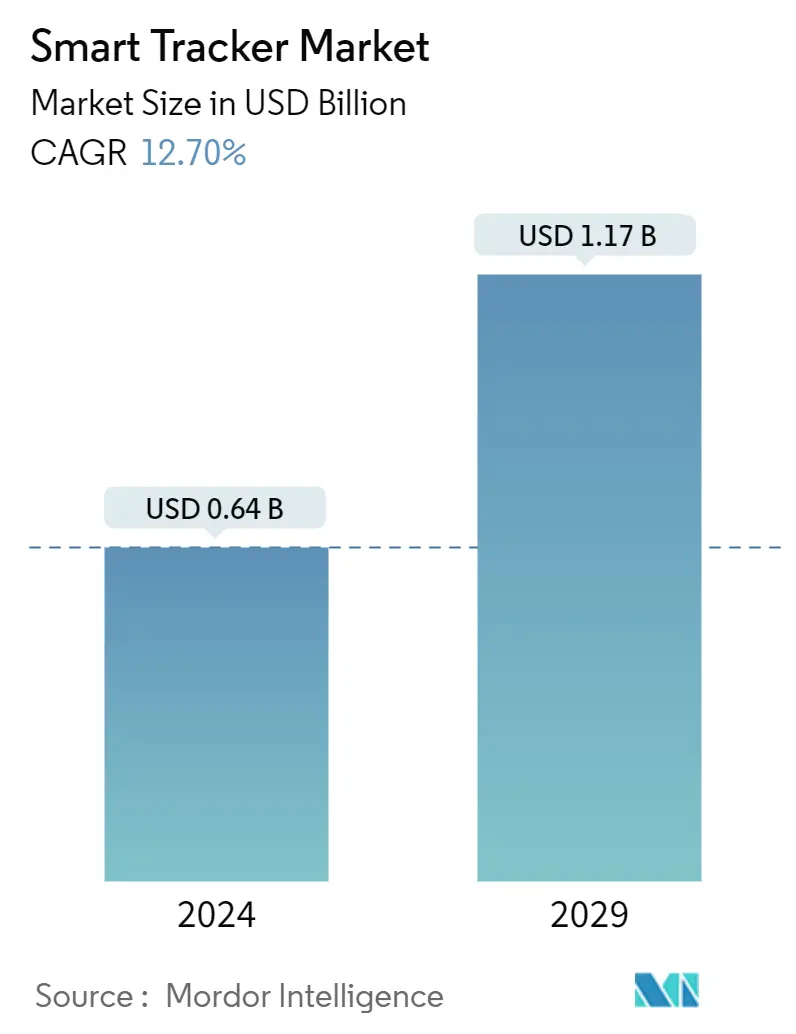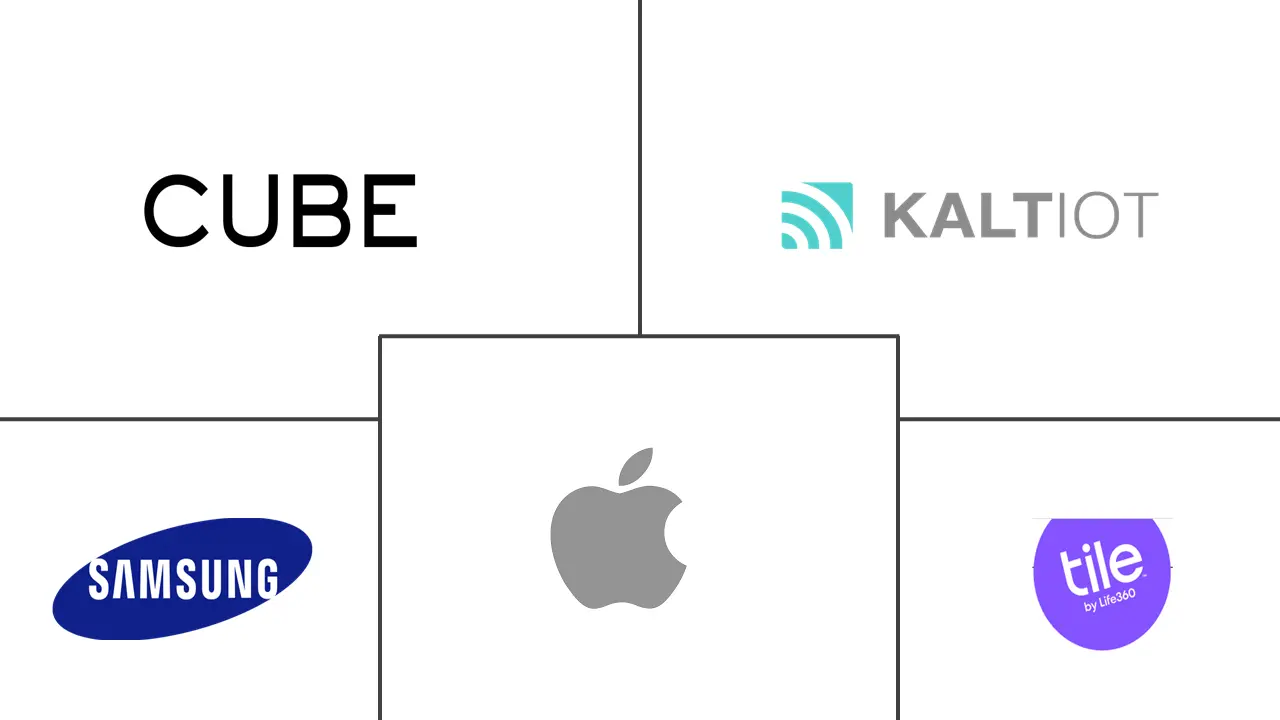Market Size of Smart Tracker Industry

| Study Period | 2019 - 2029 |
| Market Size (2024) | USD 0.64 Billion |
| Market Size (2029) | USD 1.17 Billion |
| CAGR (2024 - 2029) | 12.70 % |
| Fastest Growing Market | Asia Pacific |
| Largest Market | North America |
Major Players*Disclaimer: Major Players sorted in no particular order |
Smart Tracker Market Analysis
The Smart Tracker Market size is estimated at USD 0.64 billion in 2024, and is expected to reach USD 1.17 billion by 2029, growing at a CAGR of 12.70% during the forecast period (2024-2029).
The growth of the smart tracker market can be influenced by factors such as augmented consumer awareness of health and fitness, the surge in demand for personal and asset security, advancements in sensor technologies, integration with smartphones and other devices, expanding applications in logistics and supply chain management, and the growing trend of wearable technology adoption.
- Furthermore, rising awareness of staying healthy and fit and monitoring fitness activities is expected to augment the market’s growth. These tracking devices have come from mere pedometers to more intelligent devices with colored displays that monitor heart rate, sleep patterns, activity trackers, and others.
- The fitness industry foresees a good amount of wearable device adoption, particularly among the younger generation. To reduce the effects of a busy lifestyle, people are increasingly being persuaded to go to health clubs and gyms. Moreover, a regular workout assists in minimizing anxiety, stress, and depression. The rising health issues are pushing people not only toward a healthy diet but also toward fitness activities.
- In addition, the transportation and logistics industry's adoption of smart tags and trackers drives growth in the smart tracker market. These technologies enhance real-time monitoring, improve inventory management, and increase overall efficiency in the supply chain. As industries increasingly rely on data-driven solutions, the smart tracker market is likely to experience continued expansion.
- Despite the growth potential fueled by smartphone integration, the smart tracker market faces challenges such as a lack of standardization and unreliable connectivity that deters potential users, challenging the market’s growth.
Smart Tracker Industry Segmentation
The smart tracker lower priced models will be able to track steps and overall heart rate at a most basic level. The higher-end trackers will also be able to detect sleep patterns, burn calories, and select specific activities that you do in order to report more accurately fitness objectives.
The study analyzes the smart tracker market's current market scenario and key influencers. The study considers trackers capable of attaching to certain devices, equipment, and household things connected over the network via cellular, Bluetooth, and GPS for tracking. The report is not limited to the residential sector but offers a global perspective of the smart tracker market.
The smart tracker market is segmented by technology (cellular, Bluetooth, GPS, and UWB) and geography (North America, Europe, Asia-Pacific, Rest of the World). The market size and forecasts are provided in terms of value (USD) for all the above segments.
| By Technology | |
| Cellular | |
| Bluetooth | |
| GPS | |
| UWB |
| By Geography | |
| North America | |
| Europe | |
| Asia-Pacific | |
| Rest of the World |
Smart Tracker Market Size Summary
The smart tracker market is poised for significant growth, driven by increasing consumer awareness of health and fitness, heightened demand for personal and asset security, and advancements in sensor technologies. The integration of smart trackers with smartphones and other devices, along with their expanding applications in logistics and supply chain management, is further propelling market expansion. The trend of wearable technology adoption, particularly among the younger generation, is also contributing to the market's growth. Despite challenges such as lack of standardization and unreliable connectivity, the market is expected to benefit from the widespread ownership of smartphones, which enhances the adoption of smart tracking devices by leveraging built-in technologies for seamless connectivity and location services.
In the Asia-Pacific region, the demand for smart trackers is experiencing a transformative shift across various industries, fueled by technological advancements and increased connectivity. The rapid expansion of the Internet of Things (IoT) ecosystem in the region has made smart trackers integral components of IoT solutions, enhancing operational efficiency and productivity in sectors like logistics, transportation, healthcare, and personal fitness. The market is characterized by a high degree of fragmentation, with numerous vendors offering a range of products. Prominent companies such as Tile Inc. (Life360), Samsung Electronics Co. Ltd, and Apple Inc. are leading the market, leveraging strategic partnerships to increase their market share. Recent product launches, such as Samsung's Galaxy SmartTag2 and MapmyIndia's Mappls Gadgets, highlight the ongoing innovation and competitive dynamics within the market.
Smart Tracker Market Size - Table of Contents
-
1. MARKET INSIGHTS
-
1.1 Market Overview
-
1.2 Industry Attractiveness - Porter's Five Forces Analysis
-
1.2.1 Bargaining Power of Suppliers
-
1.2.2 Bargaining Power of Buyers
-
1.2.3 Threat of New Entrants
-
1.2.4 Threat of Substitute Products and Services
-
1.2.5 Intensity of Competitive Rivalry
-
-
-
2. MARKET SEGMENTATION
-
2.1 By Technology
-
2.1.1 Cellular
-
2.1.2 Bluetooth
-
2.1.3 GPS
-
2.1.4 UWB
-
-
2.2 By Geography
-
2.2.1 North America
-
2.2.2 Europe
-
2.2.3 Asia-Pacific
-
2.2.4 Rest of the World
-
-
Smart Tracker Market Size FAQs
How big is the Smart Tracker Market?
The Smart Tracker Market size is expected to reach USD 0.64 billion in 2024 and grow at a CAGR of 12.70% to reach USD 1.17 billion by 2029.
What is the current Smart Tracker Market size?
In 2024, the Smart Tracker Market size is expected to reach USD 0.64 billion.


